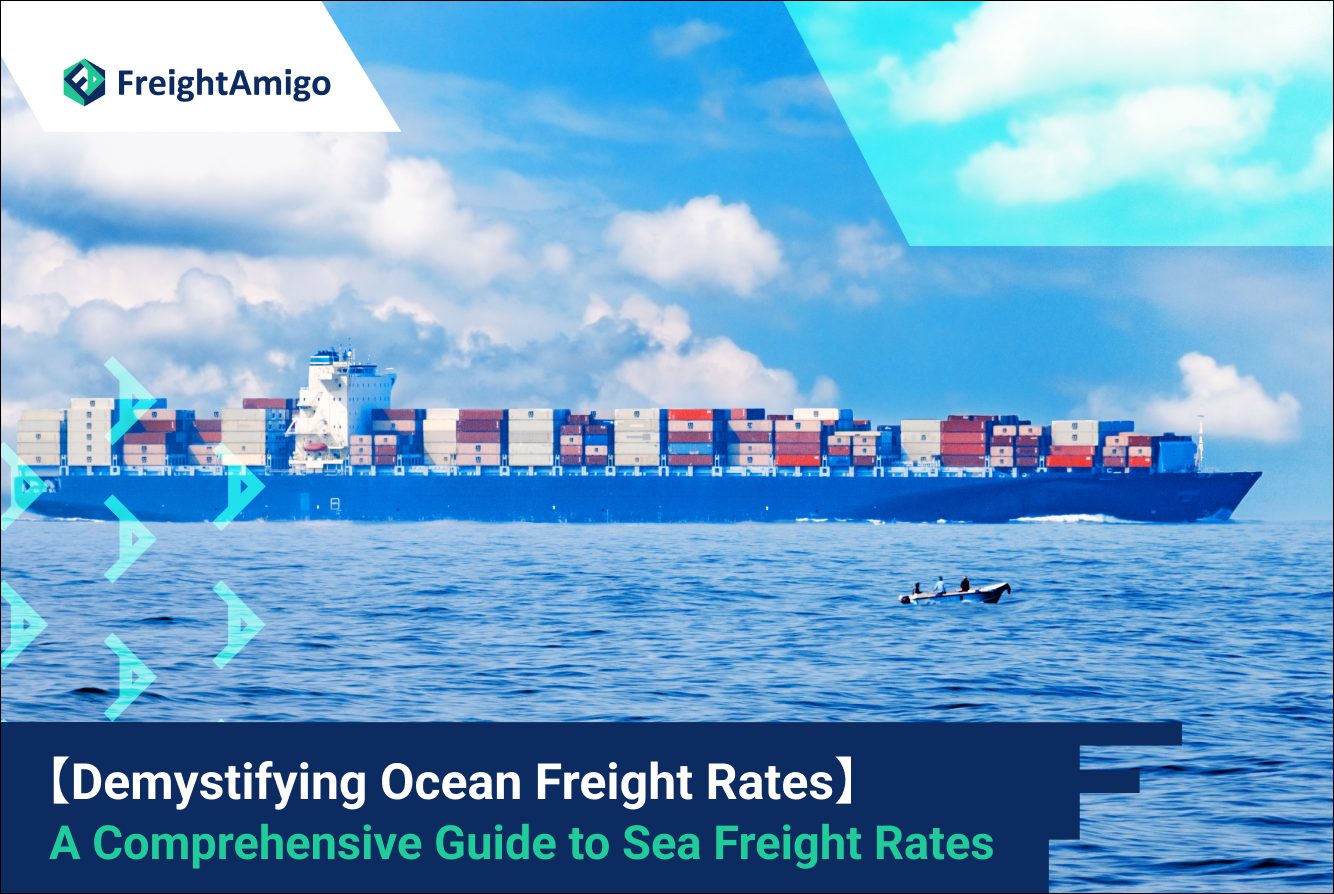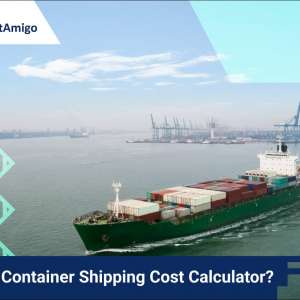Author Name: Caspian Ng – Marketing Analyst at FreightAmigo
Introduction to ocean freight rates
Ocean freight rates play a crucial role in global trade, determining the cost of transporting goods by sea. For businesses involved in international trade, understanding how these rates are calculated and what factors influence them is essential. In this comprehensive guide, we will demystify the complexities of ocean freight rates, providing you with the knowledge you need to navigate the world of shipping. Whether you are new to the industry or looking to optimize your shipping costs, this guide will equip you with the necessary information.
Want To Compare The Best Express, Air Freight, Sea Freight, Rail Freight & Trucking Rates So As To Have Better Control On Cost?
Understanding the factors that affect sea freight rates
To comprehend ocean freight rates, it is important to grasp the factors that influence them. Several key elements come into play when determining the cost of shipping goods by sea. First and foremost, the distance between the origin and destination of the shipment plays a significant role. Longer distances generally result in higher freight rates due to increased fuel consumption and time spent at sea. Additionally, the type of cargo being transported can impact the rate. Certain goods may require specialized handling, such as refrigeration or hazardous materials certifications, which can incur additional costs.
Another crucial factor is the supply and demand dynamics in the shipping industry. When there is high demand for shipping services, such as during peak seasons, freight rates tend to rise. Conversely, during periods of low demand, rates may decrease. External factors, such as geopolitical events, natural disasters, or economic conditions, can also influence ocean freight rates. It is important to stay informed about these factors and anticipate their impact on shipping costs.
Different types of ocean freight rates – FCL and LCL shipping
There are two primary types of ocean freight rates: Full Container Load (FCL) and Less than Container Load (LCL) shipping. Understanding the differences between these two options is essential for optimizing your shipping strategy.
FCL shipping is suitable for businesses with large volumes of cargo. In FCL shipping, a full container is dedicated to a single shipment. This option provides greater security and reduces the risk of damage or loss, as the container is sealed and opened only at the destination. FCL shipping also offers more flexibility in terms of loading and unloading schedules, as the container is not shared with other shipments.
On the other hand, LCL shipping is ideal for businesses with smaller cargo volumes that do not require a full container. In LCL shipping, multiple shipments from different companies are consolidated into a single container. This option allows businesses to share the cost of shipping while still benefiting from the convenience of sea freight. However, it is important to note that LCL shipping may have longer transit times and a higher risk of damage or loss due to the handling of multiple shipments.
How to calculate sea freight rates
Calculating sea freight rates can be a complex process, as it involves various factors and variables. However, having a basic understanding of the key components can help you estimate the cost of shipping.
The first step in calculating sea freight rates is determining the volume or weight of your cargo. This information is crucial, as it affects the amount of space your shipment will occupy in the container. The volume or weight is typically measured in cubic meters (CBM) or kilograms (kg), respectively.
Next, you need to consider the origin and destination of your shipment. The distance between these two points will impact the overall cost, as longer distances require more fuel and time at sea.
Once you have these details, you can approach shipping companies or freight forwarders to obtain quotes. It is advisable to request quotes from multiple providers to compare prices and services. Keep in mind that additional charges, such as customs fees, insurance, and handling fees, may also apply.
Tips for negotiating the best ocean freight rates
Negotiating the best ocean freight rates requires careful planning and strategy. Here are some tips to help you secure favorable rates for your shipments:
1. Consolidate your shipments: Whenever possible, try to consolidate multiple shipments into a single container. This can help reduce costs by sharing the transportation expenses.
2. Plan ahead: Booking your shipments in advance allows you to take advantage of lower rates and secure space on preferred vessels. Last-minute bookings often come with higher prices and limited availability.
3. Build strong relationships: Establishing long-term relationships with shipping companies and freight forwarders can lead to better rates and preferential treatment. Regularly communicate with your providers to stay updated on market trends and negotiate favorable terms.
4. Optimize packaging: Efficient packaging can help minimize the size and weight of your cargo, reducing transportation costs. Consider using lightweight materials and compact designs without compromising the safety of your goods.
How to choose the right ocean freight service provider
Selecting the right ocean freight service provider is crucial for a smooth and cost-effective shipping experience. Here are some factors to consider when choosing a provider:
1. Reputation and experience: Look for a provider with a proven track record in the industry. Check their customer reviews and testimonials to gauge their reliability and level of service.
2. Network and coverage: Ensure that the provider has a wide network of shipping lines and agents, allowing them to offer flexible routing options and comprehensive coverage.
3. Technology and tracking capabilities: A reliable provider should have advanced technology systems in place to track and monitor your shipments in real-time. This allows for better visibility and transparency throughout the shipping process.
4. Customer support: Evaluate the provider’s customer support capabilities. Prompt and responsive customer service is essential for addressing any issues or inquiries that may arise during the shipping process.
Ocean freight rate comparison: LCL vs FCL shipping
When deciding between LCL and FCL shipping, it is important to compare the two options based on your specific requirements. Here are some key points of comparison:
1. Cost: LCL shipping can be more cost-effective for smaller cargo volumes, as you only pay for the space you use. FCL shipping may offer better rates for larger volumes, considering the cost savings of dedicated containers.
2. Security: FCL shipping provides greater security, as the container is sealed and opened only at the destination. LCL shipping involves the handling of multiple shipments, which may increase the risk of damage or loss.
3. Transit times: FCL shipping often offers shorter transit times, as the container is not shared with other shipments. LCL shipping may have longer transit times due to consolidation and deconsolidation processes.
4. Flexibility: FCL shipping provides more flexibility in terms of loading and unloading schedules, as the container is dedicated to a single shipment. LCL shipping may have limited flexibility due to coordination with other shipments.
Conclusion: Simplifying the complexities of ocean freight rates
Navigating the world of ocean freight rates can be intimidating, but armed with the knowledge provided in this comprehensive guide, you can confidently optimize your shipping strategy. Understanding the factors that influence sea freight rates, differentiating between FCL and LCL shipping, and knowing how to calculate and negotiate rates will empower you to make informed decisions. Additionally, selecting the right ocean freight service provider based on reputation, network, technology, and customer support is crucial for a successful shipping experience. By simplifying the complexities of ocean freight rates, you can streamline your logistics operations and enhance your global trade endeavors.
There Are Different Options For Cargo Transportation. If You Want To Choose The Most Convenient And Suitable Solution, It Is Best To Have The Full Support Of Logistics Experts! If You Are Planning To Ship Goods Overseas, Please Go To The FreightAmigo Page For Inquiries.
===
Read More:
【Logistics News】Singapore to Sign Declaration on Green Shipping Corridors
FreightAmigo Won Startup Grand Award In TechChallenge — Digitising Trade Finance
Sailing Schedule: Streamlining Logistics Operations for Efficient Shipments
===
If you have any inquiries on logistics/supply chain, feel free to contact FreightAmigo now:
Chat with us online OR
Phone : +852 28121686
WhatsApp: +852 27467829









































